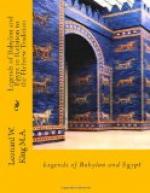It will be noticed that we here have a very similar situation to that in the Deluge story. A conference of the gods has been held; a decision has been taken by the greatest god, Enlil; and, in consequence, another deity is anxious to inform a Sumerian ruler of that decision. The only difference is that here Enlil desires the communication to be made, while in the Deluge story it is made without his knowledge, and obviously against his wishes. So the fact that Ningirsu does not communicate directly with the patesi, but conveys his message by means of a dream, is particularly instructive. For here there can be no question of any subterfuge in the method employed, since Enlil was a consenting party.
The story goes on to relate that, while the patesi slept, a vision of the night came to him, and he beheld a man whose stature was so great that it equalled the heavens and the earth. By the diadem he wore upon his head Gudea knew that the figure must be a god. Beside the god was the divine eagle, the emblem of Lagash; his feet rested upon the whirlwind, and a lion crouched upon his right hand and upon his left. The figure spoke to the patesi, but he did not understand the meaning of the words. Then it seemed to Gudea that the Sun rose from the earth; and he beheld a woman holding in her hand a pure reed, and she carried also a tablet on which was a star of the heavens, and she seemed to take counsel with herself. While Gudea was gazing, he seemed to see a second man, who was like a warrior; and he carried a slab of lapis lazuli, on which he drew out the plan of a temple. Before the patesi himself it seemed that a fair cushion was placed, and upon the cushion was set a mould, and within the mould was a brick. And on the right hand the patesi beheld an ass that lay upon the ground. Such was the dream of Gudea, and he was troubled because he could not interpret it.(1)
(1) The resemblance its imagery bears to that of apocalyptic visions of a later period is interesting, as evidence of the latter’s remote ancestry, and of the development in the use of primitive material to suit a completely changed political outlook. But those are points which do not concern our problem.
To cut the long story short, Gudea decided to seek the help of Nina, “the child of Eridu”, who, as daughter of Enki, the God of Wisdom, could divine all the mysteries of the gods. But first of all by sacrifices and libations he secured the mediation of his own city-god and goddess, Ningirsu and Gatumdug; and then, repairing to Nina’s temple, he recounted to her the details of his vision. When the patesi had finished, the goddess addressed him and said she would explain to him the meaning of his dream. Here, no doubt, we are to understand that she spoke through the mouth of her chief priest. And this was the interpretation of the dream. The man whose stature was so great, and whose head was that of a god, was the god Ningirsu, and the words




